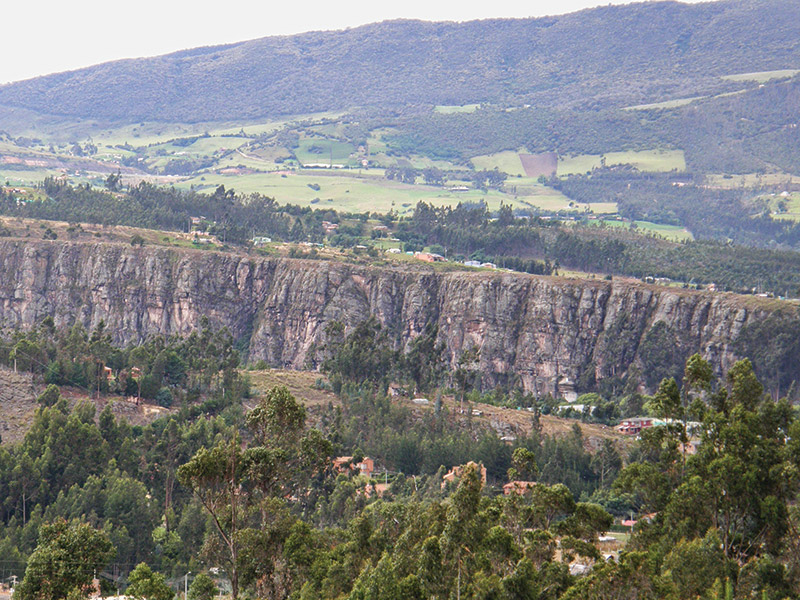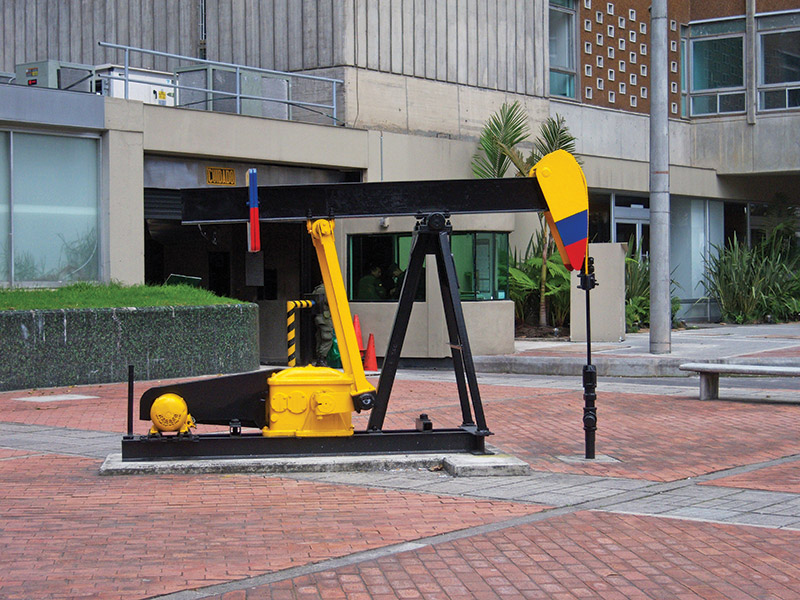Winning Hearts and Minds: Colombia and Latin American prospects offer high promise and difficult hurdles in the form of local political and public resistance.

A view of Colombia’s Eastern Cordillera-Upper Magdalena; complex geological structures like
these are only some of the challenges that exist for seismic crews and operations. Photos courtesy of Ecopetrol
Colombia has one of the world’s most complex geological landscapes – the convergence of the Caribbean, South American, Cocos and Nazca tectonic plates creates a dynamic environment and geoscientists’ dream.
And the promise of hydrocarbon discovery – both conventional resources in the offshore Caribbean and non-conventionals in the interior sub-Andean basins – have made the country a hotspot for exploration.
Foreign operators and companies, particularly from North America, are taking notice. Both Anadarko and Exxon-XTO expressed plans for 2014 during a visit to the Colombian Oil and Gas Congress in Bogotá in October – and they are just two among dozens of companies that have come to the country with high hopes.
But their quest does not come without challenges, the greatest of which are unrelated to geology.
Foreign and domestic operators are confronting two major hurdles to exploration in Colombia:
- A lengthy environmental licensing process.
- Resistance from local communities.
According to AAPG member Gustavo Carstens, a 34-year veteran geophysicist and business development adviser, while the region’s geology and technology is similar to other parts of the world, each country’s operating environment is unique.
“Running a seismic crew in the jungle in Amazonas is not the same as running a crew in West Texas or the middle of the desert in Saudi Arabia,” Carstens said.
“Any geophysicist can come to Latin America and start seismic interpretation,” he said, “but until they work with the communities and the regulators, they can’t make progress.”
Licensing
Carstens noted getting an environmental permit in Colombia can take seven months to a year.
“It is difficult for companies to keep all the key people and equipment idle for a long time if there’s no activity in other areas,” he said.
While some companies are willing to stay the course, others are unwilling or unable to make the long-term commitment.
Colombia has a lengthy licensing and permitting process, which involves site visits, community impact analyses and legal reports compiled by multiple regulators.
A primary frustration for energy companies is that exploration and production contracts in Colombia have three-year phases, while licensing and permitting process takes an average of two years of the first phase.
Companies can extend the timeline if they prove that delays were not due to negligence – but many companies do not always know about or care to apply for the extension.
While obtaining licenses and permitting is a taxing process, an even greater challenge can be working with local communities.
Communities
According to Carstens, the number one problem industry faces is that few people living in local communities understand what the industry really does.
“People are always afraid of what they don’t understand,” he said, “and if they don’t understand, the default answer is ‘no.’”
The answer was “no” in Tauramena, Casanare in December 2013, when the community voted to stop seismic exploration, drilling and transportation in the mountainous, water-rich part of the township.
Negative sentiments are echoed by Colombian senators promoting stricter regulation on seismic acquisition, which they claim has a significant negative impact on the environment.

Then there are those cty-site challenges that exist for seismic crews and operations. Photos courtesy of Ecopetrol
Region-Wide Issues
The challenges of regulatory delays and community resistance are not unique to Colombia. During the first-ever AAPG Latin America Region Energy Policy meeting, held last fall at Cartagena ICE 2013, 17 representatives from seven countries discussed strategies and struggles related to environmental restrictions and community resistance.
Those included:
♦ AAPG member Pedro Alarcon, past president of the Peruvian Geological Society, said Peru has seven regulatory agencies, “and all of them are after the oil industry.”
Non-government organizations also are involved, particularly in issues related to offshore drilling and seismic acquisition in the jungle.
♦ Brazil and Mexico – which each have a blend of federal and local regulatory authorities – and seismic acquisition, offshore drilling and hydro-fracturing are hot topics both for regulators and communities.
♦ Petrotrin and BHP Billiton’s offshore seismic surveys in Trinidad and Tobago have faced heavy resistance from the fishing industry and environmental groups.
Newspaper editorials claimed that air guns used in seismic operations drive fish away, and that fishing nets get caught in seismic lines.
Energy Policy meeting participants agreed on the need to establish a coordinated effort among local and global geoscience organizations that can provide accurate information to regulators and community members.
They also discussed working with the AAPG GEO-DC office in Washington, D.C., and the Division of Environmental Geology to develop a set of regional talking points.
Carstens, who works on public affairs as a director-at-large with the Society for Exploration Geophysicists, agreed that a coordinated, region-wide approach would provide great benefit to all involved.
“We need to explain that what we do today is completely different than what we did 20 years ago,” he said. “We bring opportunities to the communities, including development and jobs.”
Carstens said that while most companies have special divisions working on community relations, the work is not always coordinated.
“What I haven’t seen yet is coordinated work – not only with communities, but also with regulatory authorities,” he said. “We should have some kind of lobby with governments and regulatory authorities to get to a common point.”
Until that happens, companies are left to their own devices.
Success Stories
Some organizations, however, are making progress.
Trinidad and Tobago’s Ministry of Energy and Energy Affairs (MEEA) serves as facilitator of exploration activities. On a recent seismic acquisition exercise, the ministry reached out to members of the fishing industry who were concerned about seismic acquisition’s impact on their livelihood.
AAPG member Helena Inniss-King, the Geological Society of Trinidad and Tobago’s past president, said the MEEA and the seismic contractor met with fishing associations to help promote an understanding of the process.
“We showed films that highlighted the lack of harm to fish, and we explained the seismic process simply,” she said.
The seismic contractor brought a fishing liaison from the North Sea, who gave advice on better fishing methods and facilitated peer-to-peer interaction.
Inniss-King said consultation and communication are keys to working with local communities, who are more likely to cooperate with industry when they can share in the profits.
“Folks believe there is a lot of money in oil and that they should benefit,” she said. “People living in the area want work and believe they should get first preference.”
Colombian companies are using similar strategies to improve their community relations.
- Equion has worked to make social responsibility a pillar of its operations, and the company recently opened four child development centers and a business training center in Tauramena.
- National Oil Company Ecopetrol was a two-time winner of Accenture’s Innovation in Corporate Social Responsibility award; in 2013 for a strategy to prevent fuel theft, and again in 2014 for its program developing artificial reefs to recover degraded marine beds.
- Shell Colombia has worked with non-profit agencies in the Bolívar state to establish environmental recovery and protection programs as well as training for farmers and merchants.
Socioeconomic investment is on the rise throughout the country.
According to the 2013 Social Management Report (Colombian Association of Petroleum Geologists and Geophysicists), companies reported the hydrocarbon industry created 60,000 jobs for unskilled workers – 97 percent of whom were hired in areas influenced directly by operations. Also, energy companies’ voluntary social contributions in Colombia totaled 241 billion pesos ($117 million U.S.). Social investment mandated by government contracts totaled 88 billion pesos ($42 million U.S.).
Goods and services provided as a part of these investments included improved roads as well as educational facilities and job training programs.
“We go to primary and secondary schools and explain to kids what we’re doing,” Carstens said. “Those kids go back home and tell their families what they’ve learned in the schools. In communities with low education levels, what kids say has a big influence.”
These efforts not only have the potential of improving industry’s image in the region. They may also help to produce the next generation of geoscientists who will one day tackle these complex geological environments.